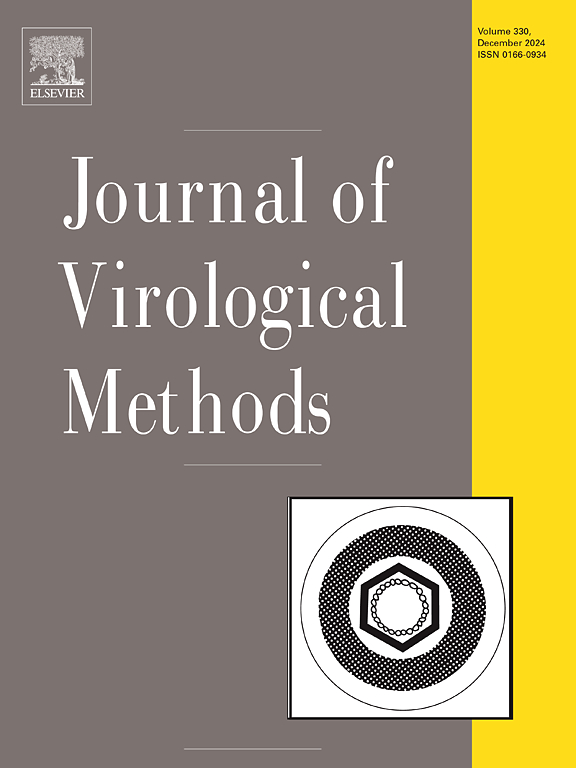Complete inactivation of orthoflavi- and alphaviruses by acetone for safe titering by ELISA
IF 1.6
4区 医学
Q3 BIOCHEMICAL RESEARCH METHODS
引用次数: 0
Abstract
The tissue culture infectious dose 50 (TCID50) end-point dilution assay is the gold-standard assay to titer viruses with negligible or ambiguous cytopathic effects. The assay’s specificity is improved when followed by an Enzyme-Linked Immunosorbent Assay (ELISA) to detect viral antigens. Cells infected with mosquito-borne orthoflavi- and alphaviruses are fixed after TCID50, prior to ELISA, using paraformaldehyde (PFA) or acetone. While 4 % PFA has been shown to effectively inactivate these viruses for safe handling in low biocontainment conditions, equivalent studies have not been reported for standard acetone fixation methods (20 % acetone for 24 hours at 4°C). This study evaluated the inactivation efficacy of acetone on orthoflavi- and alphaviruses using dengue virus (DENV) and Ross River virus (RRV), as exemplar viruses from each genus, respectively. We show that 50 % acetone and 4 % PFA fully inactivate DENV and RRV, but 20 % acetone does not reduce the infectivity of these viruses. Importantly, ELISA-based detection of DENV- and RRV-infected cells fixed with 50 % acetone was effective, with calculated titres comparable to cells treated with 20 % acetone. Together, our results inform a fixation method for titrating orthoflavi- and alphavirus samples by TCID50/ELISA, ensuring the safe handling and processing of these viruses under low biocontainment conditions.
丙酮完全灭活原黄病毒和甲病毒,用于ELISA安全滴度
组织培养感染剂量50 (TCID50)终点稀释试验是滴定可忽略或模糊细胞病变效应的病毒的金标准试验。当采用酶联免疫吸附试验(ELISA)检测病毒抗原时,该检测方法的特异性得到了提高。感染蚊媒原黄病毒和甲病毒的细胞在TCID50后,ELISA前用多聚甲醛(PFA)或丙酮固定。虽然4 % PFA已被证明可以有效灭活这些病毒,以便在低生物控制条件下安全处理,但标准丙酮固定方法(20 %丙酮在4°C下放置24 小时)的等效研究尚未报道。本研究分别以登革病毒(DENV)和罗斯河病毒(RRV)为例,评价了丙酮对正黄病毒和甲病毒的灭活效果。我们发现,50% %丙酮和4% % PFA完全灭活了DENV和RRV,但20% %丙酮不能降低这些病毒的传染性。重要的是,用50% %丙酮固定的DENV和rrv感染细胞的elisa检测是有效的,其计算滴度与用20% %丙酮处理的细胞相当。总之,我们的结果为用TCID50/ELISA滴定原黄病毒和甲病毒样品提供了一种固定方法,确保了这些病毒在低生物控制条件下的安全处理和处理。
本文章由计算机程序翻译,如有差异,请以英文原文为准。
求助全文
约1分钟内获得全文
求助全文
来源期刊
CiteScore
5.80
自引率
0.00%
发文量
209
审稿时长
41 days
期刊介绍:
The Journal of Virological Methods focuses on original, high quality research papers that describe novel and comprehensively tested methods which enhance human, animal, plant, bacterial or environmental virology and prions research and discovery.
The methods may include, but not limited to, the study of:
Viral components and morphology-
Virus isolation, propagation and development of viral vectors-
Viral pathogenesis, oncogenesis, vaccines and antivirals-
Virus replication, host-pathogen interactions and responses-
Virus transmission, prevention, control and treatment-
Viral metagenomics and virome-
Virus ecology, adaption and evolution-
Applied virology such as nanotechnology-
Viral diagnosis with novelty and comprehensive evaluation.
We seek articles, systematic reviews, meta-analyses and laboratory protocols that include comprehensive technical details with statistical confirmations that provide validations against current best practice, international standards or quality assurance programs and which advance knowledge in virology leading to improved medical, veterinary or agricultural practices and management.

 求助内容:
求助内容: 应助结果提醒方式:
应助结果提醒方式:


